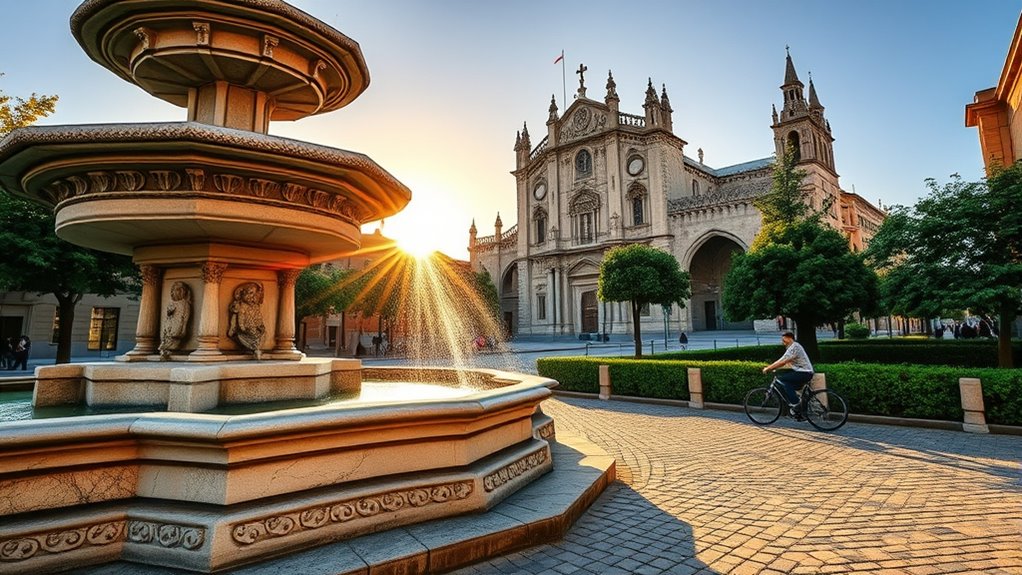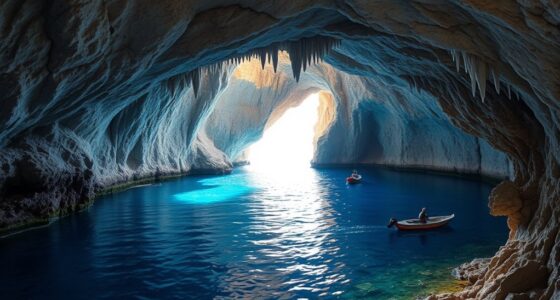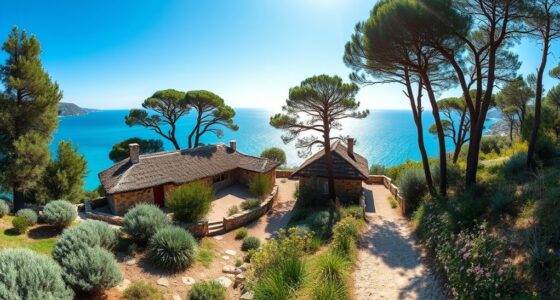Exploring the monuments of Sassari reveals a city filled with historic religious sites like the Basilica of San Gavino and churches showcasing Romanesque, Gothic, and Baroque styles. Don’t miss the iconic Rosello Fountain, symbolizing resilience and history, or the civic landmarks like Palazzo d’Usini and the University Palace. Nearby archaeological wonders, such as Monte d’Accoddi, reveal Sardinia’s prehistoric past. To discover more about Sassari’s rich cultural soul, keep exploring its remarkable monuments and stories.
Key Takeaways
- Sassari boasts diverse architectural monuments, from medieval city walls to Renaissance palaces and Baroque churches.
- Iconic landmarks include the Rosello Fountain and St. Gavino’s Basilica, symbolizing civic pride and religious heritage.
- The city’s archaeological sites, like Monte d’Accoddi, reveal prehistoric rituals and early Sardinian civilization.
- Civic buildings such as Palazzo d’Usini and the Ducal Palace showcase Renaissance and neoclassical civic architecture.
- Sassari’s monuments reflect a layered history, blending Roman, Gothic, Baroque, and modern influences.
Historic Religious Sites of Sassari
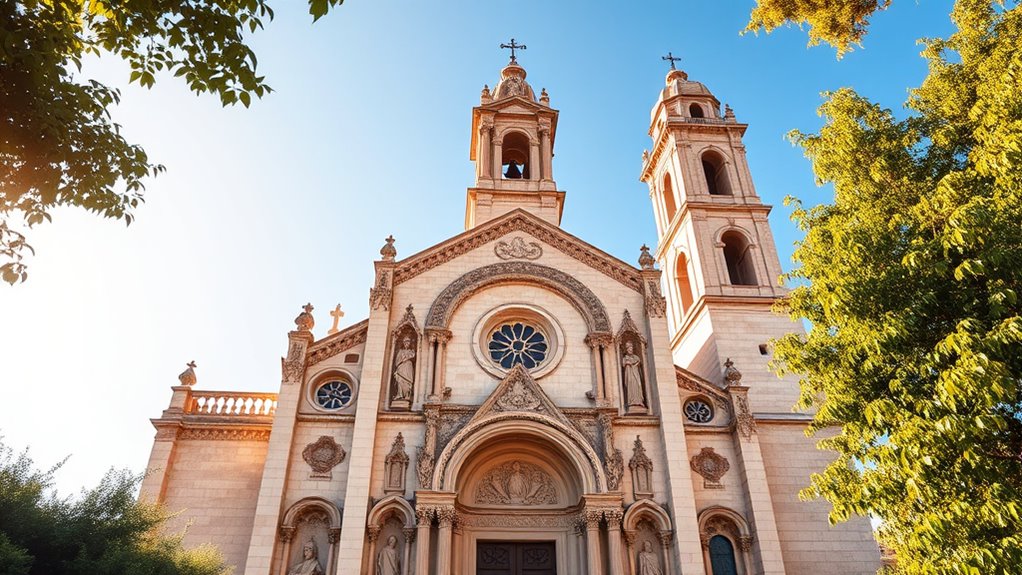
The historic religious sites of Sassari stand as living witnesses to the city’s rich spiritual and architectural heritage. When you visit the Sassari Cathedral, you’ll notice its impressive Romanesque style, later enhanced with Gothic and Baroque details, especially on the façade adorned with statues of saints. The Church of Santa Maria di Betlem, dating back to the 13th century, features a Gothic structure with modifications over time, reflecting its link to a Franciscan convent. Although the Church of San Paolo from the 17th century remains closed, it represents a layered history, possibly built on Roman foundations. These sites, through their diverse styles and historical significance, continue to shape Sassari’s religious and cultural identity, serving as essential links to its past. Additionally, these monuments exemplify architectural diversity, showcasing the evolution of building styles across different historical periods.
Architectural Marvels of Civic and Cultural Significance
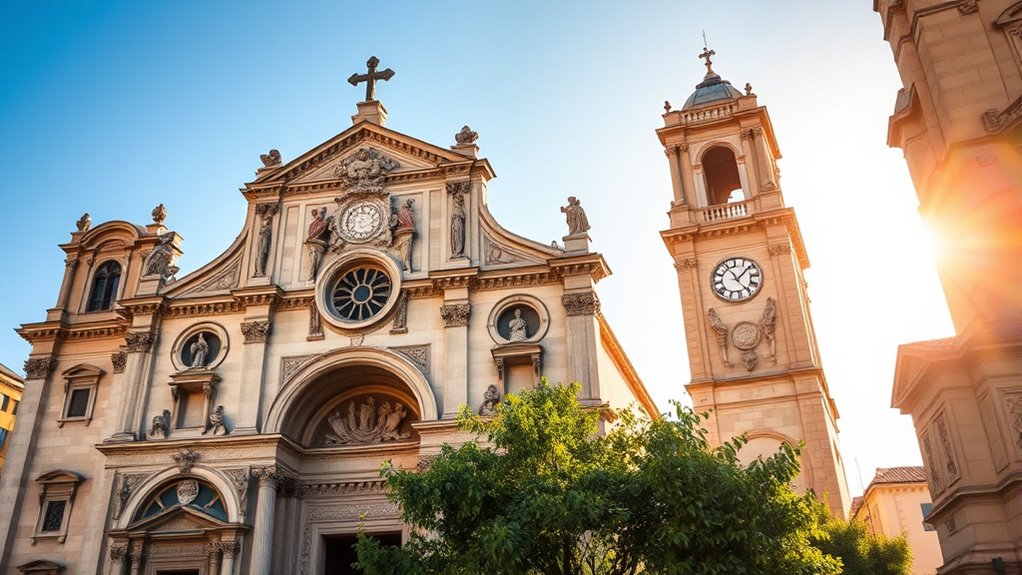
Sassari’s civic and cultural landscape is marked by architectural marvels that reflect its historical evolution and societal priorities. You can explore structures that showcase Sardinia’s progression from medieval to modern times, emphasizing civic pride and cultural development. – Palazzo d’Usini, built in 1577, is Sardinia’s first civic Renaissance building, now hosting the Municipal Library. – The Castle of Sassari and its Barbican demonstrate military innovation with firearm-resistant defenses from the 16th century. – Palazzo della Provincia, from the 19th century, features neoclassical design and stands at the heart of Piazza d’Italia, symbolizing unity. – The University Palace blends centuries of architectural styles, representing Sassari’s educational evolution. – Teatro Verdi, an elegant 19th-century theater, embodies the city’s cultural engagement and artistic identity. – The city’s rich architectural heritage includes several notable churches and public buildings that highlight its historical significance and evolving aesthetic preferences.
Iconic Public Monuments and Statues

You’ll notice Sassari’s public monuments, like the Rosello Fountain, which symbolizes the city’s history and seasons through its intricate sculptures. St. Gavino’s statue honors the city’s religious and civic identity, standing as a cherished landmark. Meanwhile, Piazza d’Italia’s architecture and central statue reflect Sassari’s post-unification modernization and civic pride. The Rosello Fountain is particularly notable as a symbol of the city and a reminder of its historical water sources.
Fountain of Rosello Significance
Standing as a symbol of Sassari’s rich history, the Fountain of Rosello captures attention with its striking Renaissance design and cultural significance. Built between 1603 and 1606, it replaced an older water source and served as essential for the city’s daily life, especially during times of crisis like plagues. Its architectural features include two casson-shaped bodies, quadrangular towers, and a circular tower with the Aragon coat of arms. The fountain’s cultural importance extends beyond utility, representing the passage of time with twelve mouths for months and four statues for seasons. It’s also celebrated in Sardinian stamps, highlighting its iconic status. Throughout history, it’s been a gathering point and a symbol of resilience, connecting Sassari’s past with its present. Located in Rosello valley outside Sassaris walls, under a bridge, the fountain’s strategic position made it accessible and central to the community’s daily activities. Its preservation is a testament to the community’s appreciation for historical monuments and their significance in shaping local identity.
St. Gavino’s Civic Symbol
Although St. Gavino’s Basilica is primarily a religious site, it holds cultural significance beyond faith as a symbol of Sardinian heritage. Located in Porto Torres, it’s the largest Romanesque monument on the island, dedicated to Saint Gavino, a Roman garrison commander martyred for his faith. Its architecture, blending Roman, Byzantine, and Gothic elements, reflects the island’s historical layers. The basilica’s relics and ancient artifacts connect locals to their past, fostering regional pride. While not a civic monument in Sassari itself, its influence extends throughout Sardinia, embodying resilience and spiritual identity. Visitors and locals alike see it as a testament to Sardinian history, making it an iconic symbol that encapsulates the island’s religious and cultural legacy. The basilica’s construction and preservation also highlight the enduring importance of religious architecture in maintaining regional traditions and identity. Additionally, the basilica’s architectural style demonstrates the diverse cultural influences that have shaped Sardinian heritage over centuries.
Piazza D’italia Architecture
Piazza d’Italia stands as a vivid showcase of Sassari’s late 19th-century urban development, reflecting the city’s embrace of modernization after Italy’s unification. At its heart, you’ll find the Monument to Vittorio Emanuele II, a marble statue crafted by Giuseppe Sartorio and inaugurated in 1899, symbolizing national unity. This monument acts as the square’s focal point, around which the entire layout revolves. The square’s design, completed within four years after 1872, features grand architecture that highlights civic pride. Key buildings like Palazzo della Provincia and Palazzo Sciuti frame the space, showcasing Neo-Renaissance and late 1800s style. Sculptural elements and statues emphasize patriotic themes, blending art with history. The square remains a hub for cultural events, linking architecture to Sassari’s living traditions. Additionally, the design and layout of the square exemplify urban planning, reflecting deliberate choices to enhance civic identity and community engagement.
- Central marble statue of Victor Emmanuel II, a symbol of unity
- Designed as Sassari’s main public space after urban expansion
- Surrounded by grand late-19th-century civic architecture
- Sculptural and decorative elements emphasize patriotic themes
- Hosts cultural events like Cavalcata Sarda and Discesa dei Candelieri
Archaeological Wonders Near the City
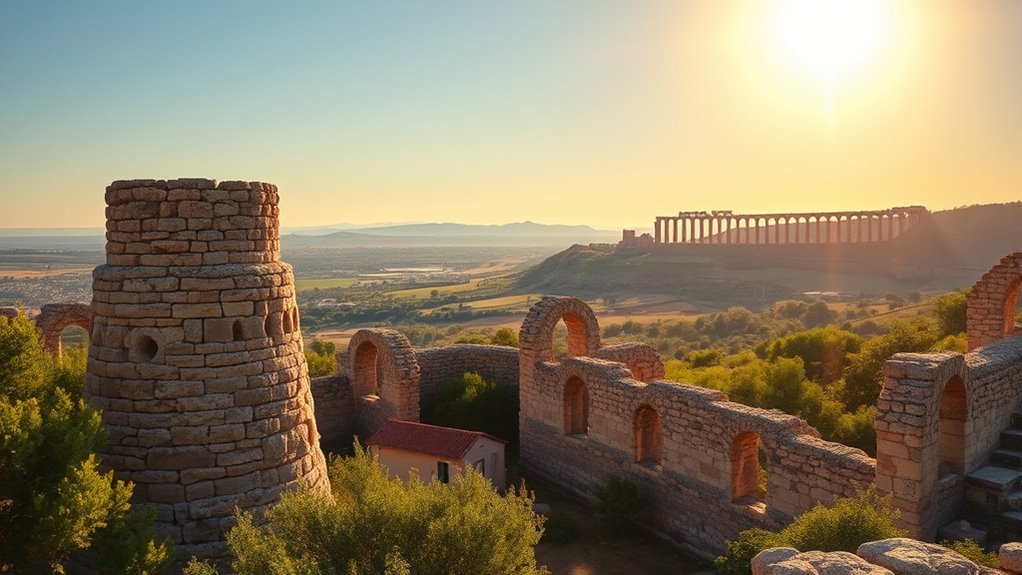
Just outside Sassari, a wealth of archaeological wonders awaits exploration, revealing the island’s prehistoric past. Monte d’Accoddi, about 11 km away, stands out with its massive stepped altar, resembling Mesopotamian ziggurats, serving as a sacred site for ancient rituals. Large carved stones, including two limestone slabs—one weighing 8 tons—may have been used for offerings or sacrifices. Nearby, menhirs and an overturned stone mark a ritual landscape predating the sanctuary. Close by, the Domus de Janas of Montalè offers underground tombs decorated with taurine protomes, reflecting complex funerary beliefs. These sites, along with scattered menhirs and surrounding necropolises, provide insight into Sardinia’s prehistoric spiritual practices, connecting natural landmarks with early religious and ceremonial activities. These sites are crucial for understanding the spiritual and cultural development of early Sardinian communities. Additionally, the perishable items found at some sites suggest that early inhabitants may have used organic materials in their rituals, highlighting the importance of preservation techniques in archaeology.
The Evolution of Sassari’s Urban Landscape
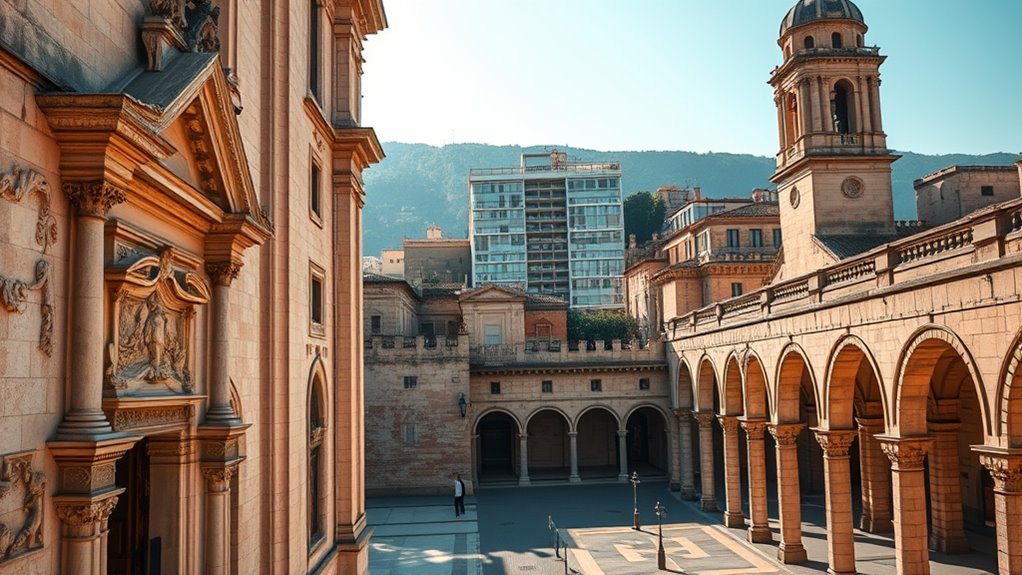
As you explore Sassari’s monuments, you’ll notice how its architecture reflects different eras, from medieval fortifications to Baroque influences. The city’s urban planning has evolved with expansions and reforms, shaping its modern layout. Understanding these changes helps you see how Sassari’s past continues to influence its present-day character. The 1836 urban expansion marked a significant turning point, allowing the city to grow beyond its medieval walls and modernize its infrastructure. This expansion introduced new urban design principles, which have contributed to the city’s current aesthetic and functional development.
Architectural Styles Over Time
The evolution of Sassari’s urban landscape reveals a rich tapestry of architectural styles that reflect its complex history. You can see Romanesque influences from the Judicates period, with structures like Porto Torres’s Basilica of San Gavino showcasing early medieval craftsmanship. Medieval military architecture, including city walls and towers, highlights defensive needs, with examples like San Pancrazio and Elephant Tower nearby. The Baroque era brought ornate churches such as Our Lady of the Rosary, with intricate façades and richly decorated interiors. In the 19th century, city walls were demolished, and industrial growth spurred new buildings, including the Caserma La Marmora. Sassari’s architecture also features elements of Neoclassical design, especially in civic buildings from the late 18th and early 19th centuries. Foundations from Roman and Phoenician civilizations underpin many of the ancient streets and underground remains, demonstrating the deep historical roots of the city. The archaeological remains continue to be a vital part of Sassari’s cultural heritage, attracting researchers and visitors alike.
Urban Expansion and Planning
Sassari’s urban landscape has evolved considerably over the centuries, shaped by its strategic location and changing political influences. Originally, the city grew from the merger of medieval villages, with fortifications built by the Judges of Torres around Castrum Sassaris in 1118. Its natural resources, like springs in Bunnari, drew settlers, and by the 13th century, Sassari became the most populous city in the Giudicato of Torres. As a medieval commune, it expanded within walls, with growth driven by commerce and regional influence. In the 19th century, the city’s partial demolition of walls allowed for new urban planning inspired by Turin, with geometric streets and squares. Modern expansion extended southward, transforming Sassari into a more connected, industrial city. The influence of urban planning principles from other European cities helped shape its contemporary layout.
Symbols of Sassari’s Cultural Heritage

Among the symbols that define Sassari’s rich cultural identity, the Rosello Fountain stands out as an iconic landmark. Built between 1603 and 1606 by Genoese craftsmen, it showcases late Renaissance style. Funded by a public tax of a thousand “scudi,” it features twelve water spouts and statues representing the four seasons. Although three statues were destroyed in 1795 riots, they were replaced in 1828, with one now in the Town Hall. Recognized in 1975 by the Italian Postal Service, it’s Sardinia’s most famous ornamental fountain. The fountain’s construction reflects the city’s historical connection to Genoese artisans and their influence on local architecture. It’s a symbol of local craftsmanship and Renaissance artistry. Serves as a gathering point and cultural icon. Represents Sardinia’s historical resilience. Features allegories of nature’s cycles. Its architectural significance highlights the blend of local tradition and Renaissance aesthetics. Continues to inspire community pride.
Notable Landmarks and Their Stories

Exploring Sassari’s symbols of cultural heritage naturally leads to a closer look at its notable landmarks, each with unique stories that shape the city’s identity. Palazzo D’Usini, built during the Renaissance, exemplifies Sardinia’s civic architecture and now serves as the main public library, symbolizing continuity from medieval times to the present. The Fountain of the Rosello, crafted in 1606 by Genoese artisans, features Saint Gavino and stands as Sassari’s Renaissance icon, linking historic and modern areas. The Cathedral of San Nicola, with its striking Baroque style, highlights the city’s ecclesiastical history and artistic influence. Piazza d’Italia, surrounded by neo-Gothic and neoclassical buildings, reflects 19th-century modernization. The city’s rich history of architecture is visible in its diverse styles, from Gothic to Baroque to Renaissance. These landmarks tell stories of Sassari’s evolving cultural, religious, and civic life, demonstrating the city’s resilience and adaptation through centuries.
The Role of Sassari’s Monuments in City Identity

The monuments of Sassari serve as powerful symbols that shape the city’s identity by embodying its historical roots and civic pride. They connect you to Sassari’s past, from medieval walls to Renaissance buildings, reinforcing a sense of community and resilience. These structures highlight the city’s autonomy, its evolution through different eras, and its cultural diversity. As you walk through the city, you see how these monuments:
Sassari’s monuments embody history, pride, and resilience, connecting past to present through architecture and cultural legacy.
- Represent Sassari’s medieval independence and civic responsibility
- Showcase architectural innovations reflecting civic pride
- Tie current urban life to historical narratives and influences
- Serve as landmarks uniting residents and visitors
- Preserve cultural memory through conservation and education
Together, they create a layered identity that celebrates Sassari’s unique history and ongoing legacy.
Celebrating Sassari’s Artistic and Historical Legacy

Sassari’s monuments not only define its identity but also celebrate its rich artistic and historical heritage. You can admire the Santa Maria di Bètlem church, where Lombard Romanesque, Gothic, Baroque, and Neoclassical styles intertwine, reflecting centuries of reconstruction. Palazzo D’Usini stands out as Sardinia’s premier Renaissance civilian building, now housing the main Public Library. The Fountain of the Rosello, crafted in 1606, embodies historic craftsmanship and civic pride. Piazza d’Italia showcases Neo-Gothic and Neoclassical architecture, highlighting Sassari’s urban growth and royal connections. The Ducal Palace, built between 1775 and 1806, symbolizes aristocratic grandeur. These monuments, along with religious sites like Cattedrale di San Nicola and artworks from different eras, celebrate Sassari’s layered artistic and historical journey, embodying its cultural resilience and identity.
Frequently Asked Questions
What Are the Most Ancient Monuments Still Visible in Sassari?
The most ancient monuments you can still see in Sassari include Monte d’Accoddi, dating back to around 4000–3650 BC, with its stepped pyramid structure used for sacred rituals. Nearby, the Necropolis of Anghelu Ruju features prehistoric chamber tombs from 4000–2500 BC, showcasing early burial practices. These sites give you a rare glimpse into Sardinia’s prehistoric past, highlighting the island’s rich ancient history before more recent civilizations took hold.
How Do Sassari’s Monuments Reflect Its Historical Influences?
You see that Sassari’s monuments showcase a mix of historical influences. The medieval walls and Aragonese Castle reveal its defensive past and shifts from military to administrative uses. Religious buildings like San Nicola Cathedral display Romanesque, Gothic, and Catalan styles, while Renaissance palaces like Palazzo d’Usini highlight cultural and civic growth. These structures reflect Sassari’s evolution from ancient settlements through medieval defense to Renaissance civic pride.
Are There Any Underground or Hidden Archaeological Sites in Sassari?
You’ll find several underground and hidden archaeological sites near Sassari. The Necropoli Su Crocifissu Mannu offers rock-cut tombs from the Neolithic and Copper Age, while the Aragonese Castle’s underground passages hide beneath the city. Monte d’Accoddi, a sacred site, features buried stones and a stepped altar. Additionally, scattered domus de janas and quarry marks reveal prehistoric burial, ritual, and mining activities, making Sassari rich in underground archaeological treasures.
Which Monument Is Most Iconic for Sassari’S Cultural Identity?
You’ll find the Fontana di Rosello is most iconic for Sassari’s cultural identity. Built in the 17th century, it symbolizes the city’s artistic heritage and history, with twelve mouths representing months and four statues for seasons. It’s a beloved symbol, capturing Sassari’s spirit, and stands beside the historic Rosello hill. As a focal point, it reflects both artistic innovation and the city’s enduring cultural pride, making it truly emblematic.
How Have Sassari’S Monuments Been Preserved or Restored Over Time?
You’ll find that Sassari’s monuments have been carefully preserved and restored over time. You can see the remaining medieval walls integrated into the city, with efforts focused on protecting these historic structures. Religious sites like the Cathedral of St. Nicholas have undergone significant renovations to maintain their character. Additionally, archaeological finds like the Giants of Mont’e Prama have been restored and displayed, blending history with modern urban life to preserve Sassari’s cultural heritage.
Conclusion
So, next time you stroll through Sassari’s streets, don’t just admire the monuments—imagine the drama, the history, and maybe even the secret lives of those stone figures. After all, who knew a statue could hold so many stories? Whether you’re a history buff or just here for the selfies, Sassari’s monuments promise more than meets the eye. Prepare to get monumentally intrigued—literally.
